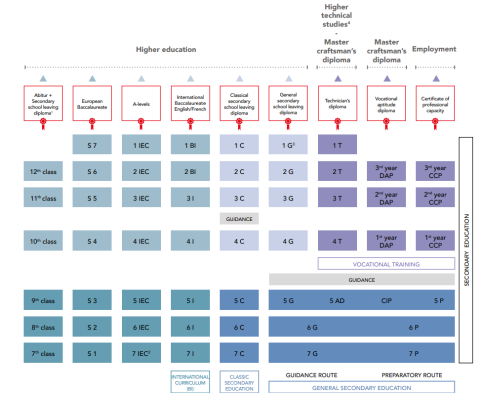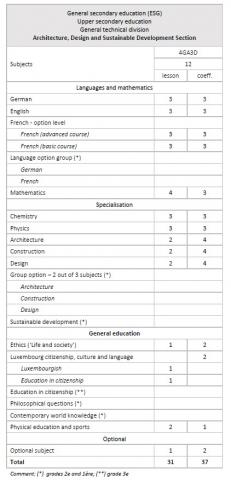Address
Unité nationale d'Eurydice
ANEFORE ASBL
eduPôle Walferdange
Bâtiment 03 - étage 01
Route de Diekirch
L-7220 Walferdange
Tel: +352 247 85289
E-Mail:info@anefore.lu
Website: www.anefore.lu
Types of institutions
Secondary education is delivered by high schools called lycées. Some of these exclusively provide either 'classic' secondary education (ESC) or 'general' secondary education (ESG). Other establishments offer both types of provision.
The Ministry of Education's publication on Key figures of the education system mentions, for school year 2023/24, a total of 42 public and 12 private secondary schools. 40 241 pupils were following the national curriculum, whereas 12 105 pupils were taught with an international curriculum. The schooling offer is becoming more and more diversified in order to match the diversity of the pupils and their needs.
Secondary schools are placed under the direct authority of the minister of Education, Children and Youth and have to comply with the minister's current directives on programmes, certificates, admission and human resources.
Within this framework, however, the modified law of 25 June 2004 on the organisation of secondary schools confers lycées a certain degree of autonomy with regard to:
- Contents and teaching methods
- Organisation of teaching
- Financial management.
This relative autonomy aims at allowing secondary schools some degree of flexibility to address specific challenges related to the institution or to their student population.
Geographical accessibility
Education hubs
Since the entry into force of the sectoral master plan for lycées (plan directeur sectoriel 'lycées') in 2005, secondary schools are organised in 4 education hubs: North, South, East and Centre (Centre-North and Centre-South). The hubs themselves are subdivided into neighbourhood areas around the existing and planned lycées.
Each of these education hubs has to offer all the current programmes of secondary education and thrives to achieve the best possible coordination between its different secondary schools.
Pupils are usually admitted to the neighbourhood area secondary school that provides the type of education recommended by the guidance decision they received at the end of elementary education (see 5.3.- Assessment in primary education). If the number of enrolments exceeds the neighbourhood school’s capacities, the pupils have the right to enrol in another establishment located within the same educational hub.
Upon a reasoned request, pupils may also attend secondary schools outside that zone. In this case, they are not entitled to claim special transport arrangements.
Transport
Since 1 March 2020, public transport in Luxembourg can be used free-of-charge throughout the country and for all modes of transport - trams, trains, and buses. This social measure applies to all users – residents, cross-border commuters or tourists.
Admission requirements and choice of school
In principle, pupils are free to enrol in the establishment of their choice, if there is sufficient availability. They have priority at a lycée of their municipality’s neighbourhood area.
The main criteria for the school's admission decision are the guidance decision established at the end of elementary education and pupil's place of residence.
Registration takes place from the end of June to the beginning of July. Students' applications have to include the following documents:
- Guidance decision of the preceding year
- Completed registration form
- Expanded residence certificate in the name of the student
- End-of-cycle assessment report of cycle 4
- Recent passport photograph of the pupil
Age levels and grouping of pupils/students
Classes are of one single level. There is a teacher for each subject. Depending on the school's practices concerning continuity, timetable availability and staff wishes, a teacher may go on with a class for several years in a row, but there is no general rule in that respect.
Classes are to be split if they have more than 29 students. In practice, though, the average number of students per class in public schools is reasonably lower.
In classic secondary education (ESC) students' theoretical age at the beginning of the school year ranges from 12 to 19 years (7 years of schooling).
In general secondary education (ESG), ages at the beginning of the school year may go from 12 to 18 years (19 for some professions of the health and social sector; 17 for learners in VET pathways).
Stages of secondary education
The graphic below shows the stages of Luxembourgish secondary education. It shows the pathways of ESC classic secondary and the ESG general secondary:
- Classic secondary education (ESC) is academically-oriented and lasts 7 years; the final diploma allows access to further higher studies and university
- General secondary education (ESG) offers a vocationally-oriented study choice and mainly prepares students to working life; studies last between 6 and 8 years depending on the pathway chosen; the final certification obtained allows its holder various prospects: higher education, higher technical or vocational studies or access to the job market as a qualified worker.

(Source: MENJE, The Public School System in Luxembourg 2024-2025)
A- Classic secondary education (ESC; enseignement secondaire classique)
The structure of ESC comprises two main levels:
1. Lower secondary years in classic secondary education are the first three years, i.e. grades called 7e, 6e and 5e.
In the first year (grade 7e), syllabi are the same for all pupils. The language of instruction is German, except for mathematics which is taught in French. To help learners with difficulty in the language of instruction, the education system offers specific language-related support and alternatives (see 6.2. - Teaching and learning in general education, as well as 6.10. - Organisational variations and alternative structures).
During the first year (grade 7e), the pupils adapt to the secondary education system.
At the beginning of the 2nd year in ESC (grade 6e), a choice of a third language is being offered: English, Latin or Chinese (in which cases English comes in as a fourth language the following year, i. e. in grade 5e)
2. Upper secondary years of classic secondary education are structured as follows:
- Polyvalent cycle (grade 4e) : the aim of this transition year is to guide pupils towards one of the sections of the specialisation cycle. Pupils may also be directed towards general secondary education (ESG) or vocational training
- Specialisation cycle: in the last three years (grades 3e, 2e and 1ère), pupils enrol in one of the following sections:
- Section A: modern languages
- Section B: mathematics - information technology
- Section C: natural sciences - mathematics
- Section D: economic sciences - mathematics
- Section E: arts
- Section F: music
- Section G: humanities and social sciences
- Section I: informatics - communication
- Section N: entrepreneurship, finance and marketing
- Section P: cognitive science and humanities
- Section R: politics and sustainable development.
In the framework of their relative management autonomy, schools may offer a varied choice in order to meet their learners' personal needs and ambitions.
Upon successful completion of the specialisation cycle and its final examination at the end of grade 1ère, students obtain the classic secondary school leaving diploma.
B- General secondary education (ESG; enseignement secondaire général)
ESG prepares pupils for higher and university studies, the brevet de technicien or the brevet de maîtrise.
The general secondary final diploma allows access to higher education. Other pathways in ESG prepare the learners to professional life.
General secondary education is structured in:
- Lower classes (7e, 6e, 5e): in the orientation or pre-vocational education. The pre-vocational education is structured along modular lines allowing each pupil to progress at his/her own pace
- Higher classes (4e to 1re): based on the promotion decision at the end of grade 5e, pupils can continue with the initial vocational training in one of the following streams (each stream ma include several subject areas):
- administration and commercial stream
- arts stream
- hotel management and tourism stream
- health and social professions stream
- general technical stream.
Upon successful completion and its final examination at the end of grade 1ère, students obtain the general secondary school leaving diploma.
Organisation of the school year
The academic year is organised in trimesters or in semesters.
The school year generally starts on 15 September (or the first work day following this date) and ends by 15 July. Beginning and ending dates are defined by a multi-annual grand-ducal regulation, which also determines the days of school holidays. In principle, at least one holiday week is scheduled every 6 weeks.
Organisation of the school day and week
Classes are held on five or six days a week.
According to the modified law on the organisation of secondary schools, schools may organise their own timetables, within the legal provisions and subject to the approval of the minister and the school's education council.
A yearly grand-ducal regulation determines the number of lessons per subject, as well as each subject's weighting (coefficient). The number of lessons per week may vary according to the type and level of education.
On the Education Ministry's website, the programmes can be downloaded each year for all secondary education types. The archive goes back from today to school year 2007/08.
The duration of a lesson is 50 minutes, as fixed by the Ministry.
The table below shows a typical school week:

(Source: Lycée Aline Mayrisch)
The allocated teaching time depends on the type and level of the class, and on the students' personal additional choices. Compulsory teaching time is at minimum 30 lessons a week.
Distribution of lessons per week
The two timetables below show the lessons provided for the 4th grade of secondary education: 4th 'polyvalent' grade in ESC classic secondary (where guidance into sections takes place at the end of the year), and 4th grade in ESG general secondary, where specialisation has already been performed at the end of the preceding year. The subjects' relative weighting is shown by means of their 'coefficient'.
1. Timetable in classic secondary education (ESC)
The different language choices (offered since grade 6e) are shown as Latin (CL) and Chinese (CZH) pathways, alongside the pathway without the additional language (C).

(Source: Portal Education, Classic secondary education for the academic year 2021/2022)
2. Timetable in general secondary education (ESG)
The example below shows the subjects studied in the 4th grade of ESG (section of architecture, design and sustainable development). The study subjects are grouped into different domains: 'languages and mathematics', 'specialisation', 'general education', 'optional subjects'.

(Source: Portal Education, General secondary education for the academic year 2021/2022)
